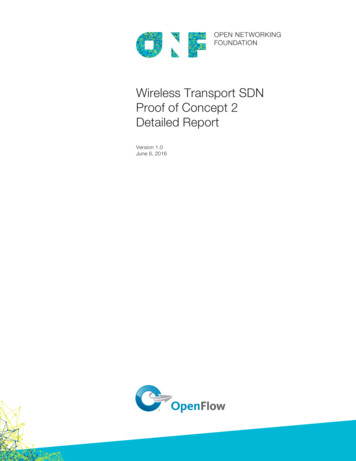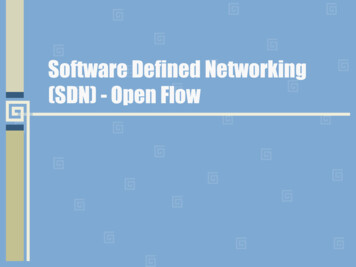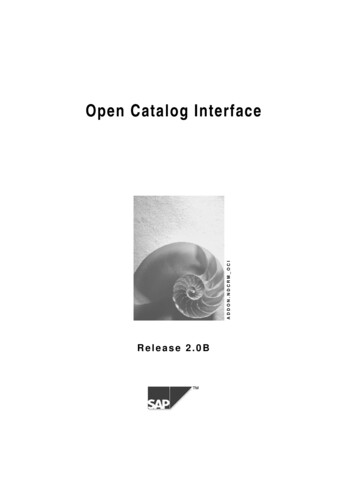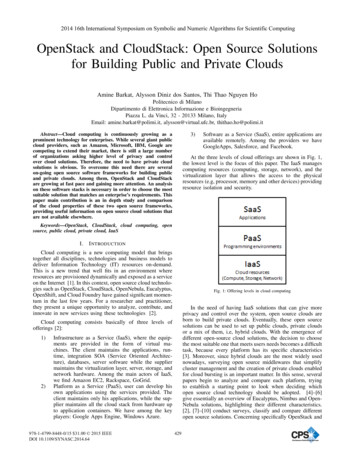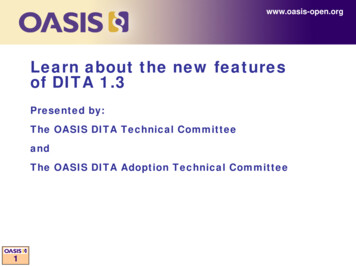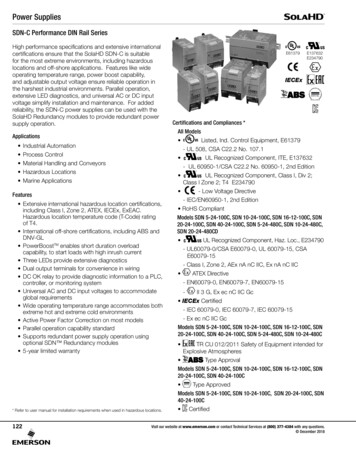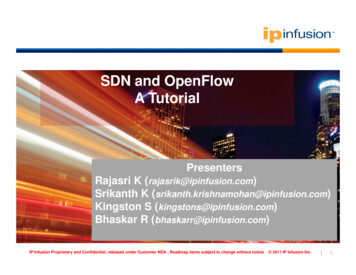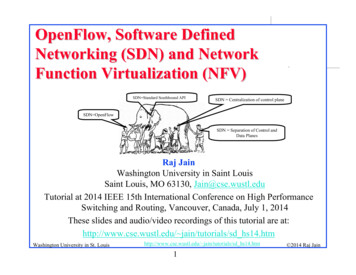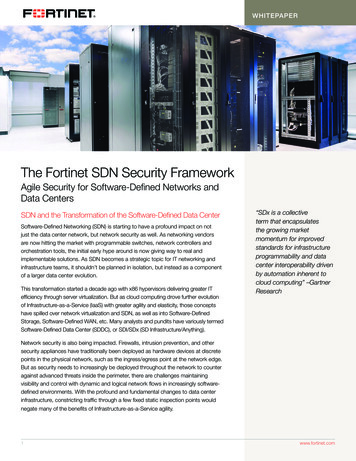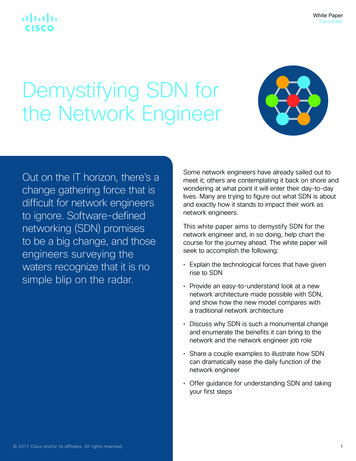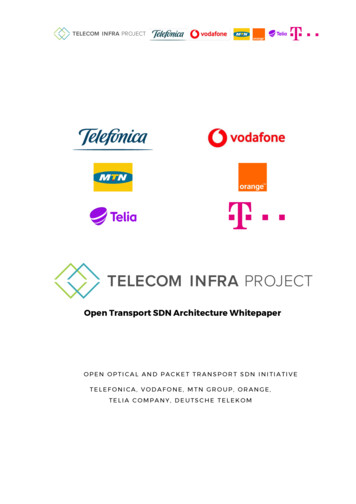
Transcription
Open Transport SDN Architecture WhitepaperOPEN OPTICAL AND PACKET TRANSPORT SDN INITIATIVETELEFONICA, VODAFONE, MTN GROUP, ORANGE,TELIA COMPANY, DEUTSCHE TELEKOM
Copyright 2020 Telecom Infra Project, Inc.A TIP Participant, as that term is defined in TIP’s bylaws, may make copies, distribute, displayor publish this Specification solely as needed for the Participant to produce conformantimplementations of the Specification, alone or in combination with its authorized partners.All other rights reserved.The Telecom Infra Project logo is a trademark of Telecom Infra Project, Inc. (the “Project”) inthe United States or other countries and is registered in one or more countries. Removal ofany of the notices or disclaimers contained in this document is strictly prohibited.The publication of this Specification is for informational purposes only. THIS SPECIFICATIONIS PROVIDED “AS IS,” AND WITHOUT ANY WARRANTY OF ANY KIND, INCLUDING WITHOUTLIMITATION, ANY EXPRESS OR IMPLIED WARRANTY OF NONINFRINGEMENT,MERCHANTABILITY, OR FITNESS FOR A PARTICULAR PURPOSE. UNDER NOCIRCUMSTANCES WILL THE PROJECT BE LIABLE TO ANY PARTY UNDER ANY CONTRACT,STRICT LIABILITY, NEGLIGENCE OR OTHER LEGAL OR EQUITABLE THEORY, FOR ANYINCIDENTAL INDIRECT, SPECIAL, EXEMPLARY, PUNITIVE, OR CONSEQUENTIAL DAMAGES ORFOR ANYCOMMERCIAL OR ECONOMIC LOSSES, WITHOUT LIMITATION, INCLUDING AS A RESULT OFPRODUCT LIABILITY CLAIMS, LOST PROFITS, SAVINGS OR REVENUES OF ANY KIND INCONNECTION WITH THE USE OR IMPLEMENTATION OF THIS SPECIFICATION. TIP does notown or control patents.Contributors to this Specification, as defined in the TIP IPR Policy, have undertaken patentlicensing obligations as set forth in the TIP’s IPR Policy which can be found v487k-efbbqr/IPR Policy Telecom Infra Project.pdfPage 2 of 26
TABLE OF CONTENTSGLOSSARY . 41EXECUTIVE SUMMARY . 52INTRODUCTION . 73TARGET SOFTWARE-DEFINED NETWORK ARCHITECTURE . 83.1Hierarchical Architecture. 83.2 Functional Components. 103.2.1Technological domain controller . 103.2.2 IP/MPLS multi-vendor SDN controller . 113.2.3 Microwave SDN domain . 113.2.4 Optical SDN domain . 123.3 Hierarchical Controller. 134AGILE NETWORK PROGRAMABILITY . 144.1Interface Consolidation . 144.1.1Northbound interfaces .154.1.2Southbound Interfaces toward network elements . 164.2 Methodology. 174.2.1Use case definition. 174.2.2 Standardization of data models . 184.2.3 NBI standards . 194.2.3.14.2.3.24.2.3.34.2.4IP network data models . 19Optical network data models . 20Microwave network data models . 20SBI standards . 205OPEN NETWORKING . 216NETWORK INTELLIGENCE . 226.16.26.36.46.5Traffic engineering. 22In-Operation Network Planning . 23E2E Transport Service Programming . 23Automation and Scheduling of Maintenance Operations . 235G Network Slicing .247CONCLUSIONS . 248REFERENCES. 26Page 3 of 26
GLOSSARYACTNabstraction and controlof TE networksNOSnetwork operating systemAPIapplication programminginterfaceOCPOpen Compute ProjectBGP-LSBorder Gateway Protocol – LinkStateONFOpen Networking FoundationeMBBEnhanced Mobile BroadbandOTNoptical transport networkGUIgraphical user interfaceODUoptical data unitIETFInternet Engineering Task ForceOSSoperations support systemsIGPInterior Gateway ProtocolPCEpath computation elementILAinline amplifierPCEPPath Computation ElementProtocolIS-ISIntermediate System toIntermediate SystemROADMreconfigurable optical add-dropmultiplexerLACPLink Aggregation ControlProtocolSBIsouthbound interfaceLDPLabel Distribution ProtocolSDNsoftware defined networkLLDPLink Layer Discovery ProtocolSDOStandards DefinitionOrganizationmMTCmassive machine-typecommunicationT-APItransport API (ONF)MOPmethod of procedureTFtunable filterMPLSmulti-protocol label switchingTIPTelecom Infra ProjectMWmicrowaveuRLLCultra-reliable low-latencycommunicationNBInorthbound interfaceVPNvirtual private networkNGMNNext Generation MobileNetworksVRFvirtual routing and forwardingNMSnetwork management systemYANGyet another next generationPage 4 of 26
1 EXECUTIVE SUMMARYOver the past few years all the telecommunications industry actors, including vendors, networkservice providers, standardization bodies (e.g., IETF, GSMA), and industry fora (e.g., ONF, OIF,OpenConfig, TMForum) have been working toward the habilitation of automatic networkcontrol and programmability. Many efforts have been made to make software definednetworking (SDN) a reality, hence a large number of architectural frameworks have beenproposed. It’s now time to define a common strategy to reduce and select the most suitablestandards to unify disparate SDN solutions.A worldwide, top-ranked network operators group—formed by Telefonica, Vodafone, MTN, TeliaCompany, DeutscheTelekom, and Orange—has joined efforts to collaborate on open transportSDN within the Telecom Infra Project’s Open Optical and Packet Transport (OOPT) projectgroup. They’ll be leading a new workstream called MUST (Mandatory Use case requirementsfor SDN for Transport). This white paper presents its common architectural view, the use casebased methodology, and the selection of the most relevant standard interfaces to beimplemented by the industry.The target reference architecture for the transport SDN controllers is hierarchical, with specificdomain controllers per technological domain (IP/MPLS, microwave, optical)and a hierarchical controller to provide real-time control of multi-layer and multi-domaintransport network resources. The operation support systems (OSS)—including serviceorchestration and service and resource inventory—will be consuming a set of APIs exposed bythe controllers to handle the data and configurations toward end users and enabling servicefulfillment.Based on common use cases defined by the operators, the set of standard SDN interfaces areselected and detailed to produce a common industry specification. The presented SDNarchitecture enables other systems in charge of planning, inventory, NFV orchestration, serviceorchestration, performance, or fault management to retrieve information and program thenetwork with well-known, vendor-agnostic interfaces. The SDN controllers will enable resourceconfiguration. The resource abstraction level exposed in the northbound interface (NBI) willdepend on the use case definition and the technology considered.Page 5 of 26
OSS LAYERAlarmsServiceOrchestrationPerformancePlanning &DesignInventoriesStandard InterfaceTelemetry, AlarmsStandard InterfaceRESTCONF/YANGSDN HierarchicalControllerStandard InterfaceTelemetry, AlarmsStandard InterfaceRESTCONF/YANGSDN DomainControllerSDN DomainControllerStandard InterfaceTelemetry, Alarms, ControlStandard InterfaceNETCONF/YANGControl/Management planeForwarding/Data planeControl/Management planeForwarding/Data planeFigure 1 – Open transport SDN architecture visionImplementing a complete standard specification is a time-consuming process. To accelerateadoption, the operators have compiled the needs of multiple operations, engineering, andplanning teams, and have selected the most relevant common use cases. Based on this,technical requirements are prepared and shared with the vendors. These specifications will beincorporated as part of future RFQ processes, which will facilitate a gradual implementation ofthe defined standards according to a given use case prioritization plan.To achieve the open programmable transport networks goal, operators will require solutionsuppliers (both hardware and software—including network operating system and controllersoftware) to include the selected standard interfaces in their commercial product releases,reducing the need for ad hoc development during solution deployment phase.The operators signing this whitepaper encourage others to join and contribute towarddefining and accelerating standardization and implementation of the required SDN interfacesand use cases needed for our transport networks.Page 6 of 26
2 INTRODUCTIONThis document summarizes the open transport SDN strategy with respect to the SDN, togetherwith objectives and activities roadmap needed to accomplish the goal of a full automatedIP/optical transport network. This document will not cover technical details associated withSDN [SDN1] and assumes the reader is familiar with the basic concepts.Over the last few years operators have worked hard on network simplification, aiming toreduce complexity, maintenance needs, and operational burden, while simultaneouslyproducing economic efficiencies within the respective areas. One step ahead, SDN aims tofulfill the same goals by advocating the need to separate the data plane (by transformingnetwork switches to simple packet forwarding devices) from the control plane (by putting acentralized software component, also known as SDN controller, in control of entire networkbehavior).It’s not foreseen that a complete separation or decoupling of the control plane is required tobenefit from the high survivability of networks against failures, disaster recovery, et al. Themore practical approach is to enhance network programmability through a hybrid,hierarchical SDN architecture, in which management and control functionalities are splitbetween devices and a set of controllers.By way of definition, service is always considered as the E2E service consumed by an end userand involves several domains and corresponding resources. Management of such services isachieved at the OSS/service orchestration layer. By contrast, the transport connectivity servicerefers to resources handled by the transport domain (IP/MPLS, optical, microwave), and can beconsidered as a part of the overall service.The main goals of the SDN approach are: Agile Network Programmability – Enabling full network automation and reducingtime-to-market of service introduction. This is achieved through a dynamic use caseoriented strategy and by standardizing network interfaces. Network Abstraction – Introducing the adequate level of abstraction at each layer ofthe architecture (network elements, domain controllers, hierarchical controller),simplifying the development of the OSSes and orchestrators. The first level is movingfrom a vendor-specific view of networks and devices to a technological one—agnosticfrom who is implementing the network function. The second level refers to specific usecases, where some device-level behavior is automatically inferred by the SDN controlmechanisms. This facilitates interactions among components and therefore overallnetwork automation. Open Transport Networks – Enabling deployment of open network devices at anytransport layer (IP, optical, MW) as suppliers implement the same configurationinterface. Controller interfaces will be based on generic functions, not on vendorspecific implementations, thereby reducing the vendor lock-in associated with closedmanagement platforms that were to be used with their own devices. Network Intelligence – Enabling traffic engineering (TE) and automated serviceprovisioning between layers and vendor technologies.Page 7 of 26
Convergence of control and management – Where traditional network managementsystems (NMS) and associated functions will be consolidated in the target SDNarchitecture.This paper initially covers the target SDN architecture with the architectural blocks. Use casemethodology is explained next, after which the candidate set of interfaces is listed. Operatorswill work together in choosing and completing the full set of use cases. To conclude, a set ofareas where the SDN approach can help operations are presented along with our conclusions.3 TARGET SOFTWARE-DEFINEDNETWORK ARCHITECTUREThis chapter defines the targeted open transport SDN architecture. It’s defined based onoperators use cases, the reality of operators’ networks, and the state of the art of technology.Main architectural blocks are presented first, after which each technology domain is exploredbased on the current technological evolution.3.1 Hierarchical ArchitectureThe preferred open transport SDN architecture within a single operator network is based on ahierarchical controller along with several technology-specific SDN controllers (Figure 2). Thisset of controllers provides information to the orchestration and support systems. (Multioperator networks are outside the scope, the assumption being that all technology domainsbelong to the same operator.)This approach facilitates the responsibility boundaries for each controller, as well as enables ahigher scalability of the solution. In case a transport segment is divided among multipleadministrative domains, multiple SDN domain controllers for the relevant transport segmentmight be included in the hierarchy.On the other hand, practical implementation of this architecture and potential integration orreplication of functional components (e.g., domain controllers or the specific functions to bedeployed) will be individually decided by each operator. This three-tier model is aligned withthe industry’s main architectures, such as ONF SDN Architecture for Transport Networks [TR522], IETF Framework for Abstraction and Control of TE Networks (ACTN) [RFC8453], and IETFFramework for Service Automation [Wu20].Page 8 of 26
OSS LAYERHierarchicalSDN ControllerNBiAlarms &EventsTopologyRESTCONFTransport ConnectivityServicesH - PCETelemetryMWMulti-VendorSDN ControllerNBiAlarms &EventsRESTCONFTransport ti-VendorSDN ControllerNETWORK DBSBiRESTCONFNBiRESTCONFAlarms &EventsTransport ConnectivityServicesTopologyNETWORK DBNETCONFMW networksTelemetrySBiOpticalMulti-VendorSDN ControllerNETCONFPCEAlarms &EventsTopologyNETWORK DBPCEPNBiBGP-LSIP/MPLS multi-vendormulti-area convergentnetworksTelemetrySBiRESTCONFTransport ConnectivityServicesPCENETWORK DBNETCONF Optical networksFigure 2 – Open transport SDN target architectureDue to its wide scope and complexity, the network transport domain is divided into threemain technology domains: IP/MPLS, microwave network (MW), and optical. Given theirdisparate physical layers, each transport technology has unique network element (NE)configuration and service requirements.Thus, the open transport SDN architecture has foreseen the control separation betweentechnologies by introducing a dedicated domain controller for microwave, IP, and opticaltransport segments. Each controls a set of network elements through a standardized,technology-dependent southbound interface (SBI) that is also vendor independent.Each controller also has a northbound interface (NBI) for communication with the hierarchicalcontroller. On top of the SDN domain layer, the hierarchical controller aggregates demandsfrom the management and service layer that includes OSS and orchestration. It exposes aunified NBI, providing resource configuration abstraction and technology agnostic servicedefinitions for consumption.Page 9 of 26
3.2 Functional Components3.2.1 Technological domain controllerThe SDN domain controllers are required to have a set of common functions independent ofthe vendor-specific implementations and considered technology domain. These include: Real-time network database – The controller will take care of collecting data from theNEs (physical and logical), making them available to be queried via NBI for inventorypurposes. The set of transport services and the TE information in each domain is alsomaintained and available for query. Transport connectivity services implementation – Configuration/modification/deletion of transport service endpoints and their parameters based on requeststhrough the NBI. The level of provided abstraction will depend on the technologies anduse cases in scope. Path computation element (PCE) – Stateful PCE will be used to manage all intradomain transport connectivity (LSPs) to calculate new LSP paths at service creation, orwhen traffic optimization is triggered by the operator—with or without TE constraints.The controller also monitors all network LSP statuses. Protection switching is stilltriggered at a network level by the corresponding transport protocols (e.g., RSVP-TE) toensure the correct survivability. There is no need for a PCE function in the MW SDNcontroller as shown in Figure 2. SBI plug-ins – Protocols needed for communication toward the NEs. For example:NETCONF/YANG for configuration manipulation executed by any SDN dom
This white paper presents its common architectural view, the use case-based methodology, and the selection of the most relevant standard interfaces to be implemented by the industry. The target reference architecture for the
